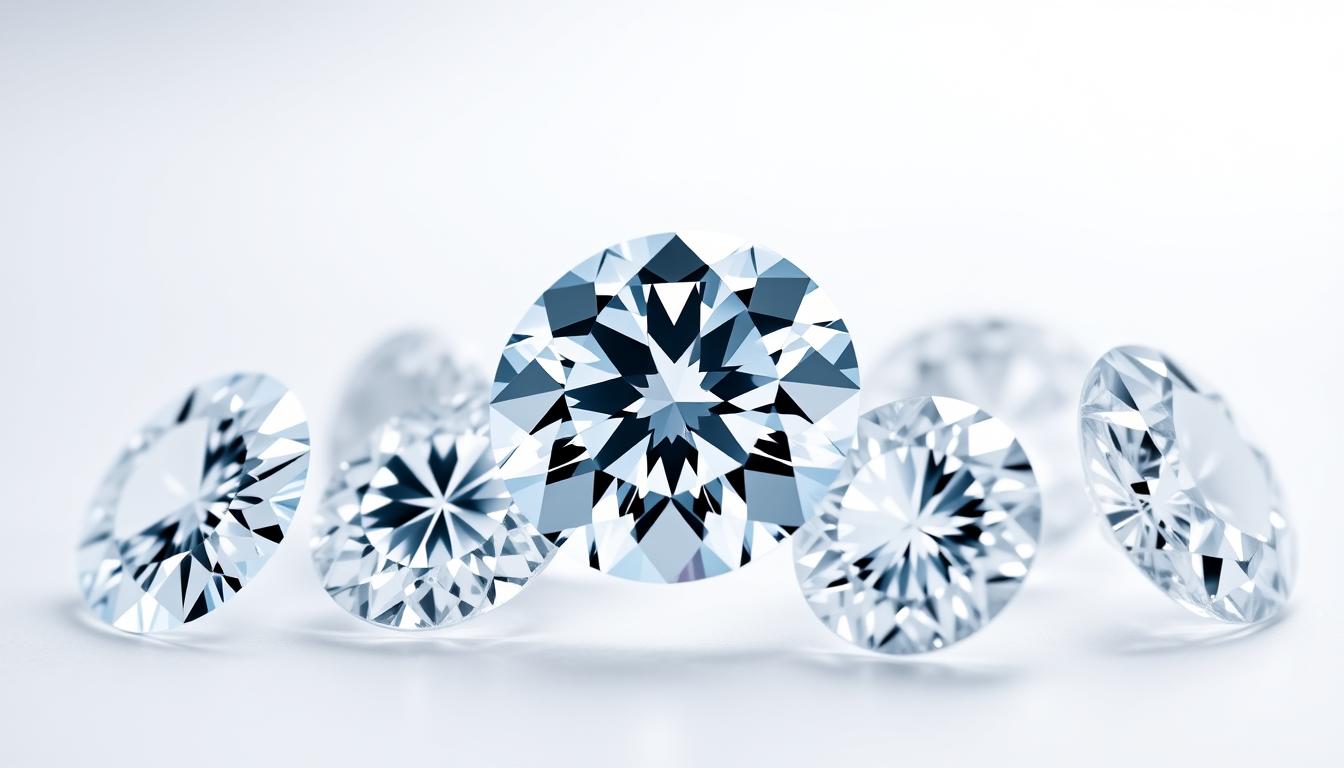When it comes to choosing the perfect engagement diamond, many factors come into play. With the rise of lab grown diamonds, consumers now have more options than ever. But what sets GIA-certified lab grown diamonds apart?
GIA’s certification process ensures that these diamonds meet the highest standards of quality. As technology advances, the lab grown diamond industry is rapidly evolving, offering consumers more choices and better value.
Understanding the pricing, quality, and benefits of GIA-certified lab grown diamonds is crucial for making an informed decision. In this guide, we’ll explore the advantages of choosing these diamonds and what to look for when selecting the perfect stone for your engagement ring.
Understanding GIA Lab Grown Diamonds
GIA’s role in grading lab grown diamonds has brought confidence to the diamond market. The Gemological Institute of America (GIA) is a renowned authority in diamond grading and certification. With a history of providing unbiased verification, GIA has established itself as a trusted name in the industry.
What Are Lab Grown Diamonds?
Lab grown diamonds are created using advanced technology that replicates the natural process of diamond formation. They have the same physical, chemical, and optical properties as natural diamonds. GIA certification confirms that a lab grown diamond meets specific standards.
“Lab grown diamonds are not imitation diamonds; they are real diamonds made through a different process,” as emphasized by industry experts. This distinction is crucial for consumers seeking authenticity.
The Role of GIA in Diamond Certification
GIA’s certification process involves a thorough examination of a diamond’s characteristics, including its cut, color, clarity, and carat. The institute’s grading report provides detailed information, ensuring transparency and confidence in diamond purchases. GIA’s rigorous testing and consistent grading standards make its certification highly valued.
A GIA certificate is a quality assurance measure, confirming that a lab grown diamond has been thoroughly examined by independent experts. This provides consumers with the assurance that their diamond is genuine and of high quality.
How GIA Certifies Lab Grown Diamonds
As lab-grown diamonds become increasingly popular, understanding how GIA certifies these stones is essential for consumers and industry professionals alike. The certification process for lab-grown diamonds is a critical aspect of ensuring their quality and authenticity.
GIA’s Certification Process for Lab Grown Diamonds
GIA’s certification process for lab-grown diamonds involves a comprehensive evaluation of the stone’s characteristics. This includes assessing the diamond’s color, clarity, cut, and carat weight, which are the key factors in determining its quality and value. GIA’s experts use specialized equipment to examine the diamond and provide a detailed report on its characteristics.
Recent Changes in GIA’s Approach to Lab Grown Diamonds
GIA has recently announced a significant shift in its approach to lab-grown diamonds, moving away from the traditional color and clarity grading system to a simplified categorization of “premium” or “standard.” This change reflects the advancements in diamond-growing technology, which have resulted in a compression of the quality range among lab-grown diamonds. According to GIA’s research, approximately 95% of lab-grown diamonds submitted for grading since 2022 fall within the colorless range (D-F), while 98% achieve clarity grades of VS1 or higher. This new categorization aims to provide consumers with clearer guidance while acknowledging the fundamental differences between natural and lab-grown diamonds.
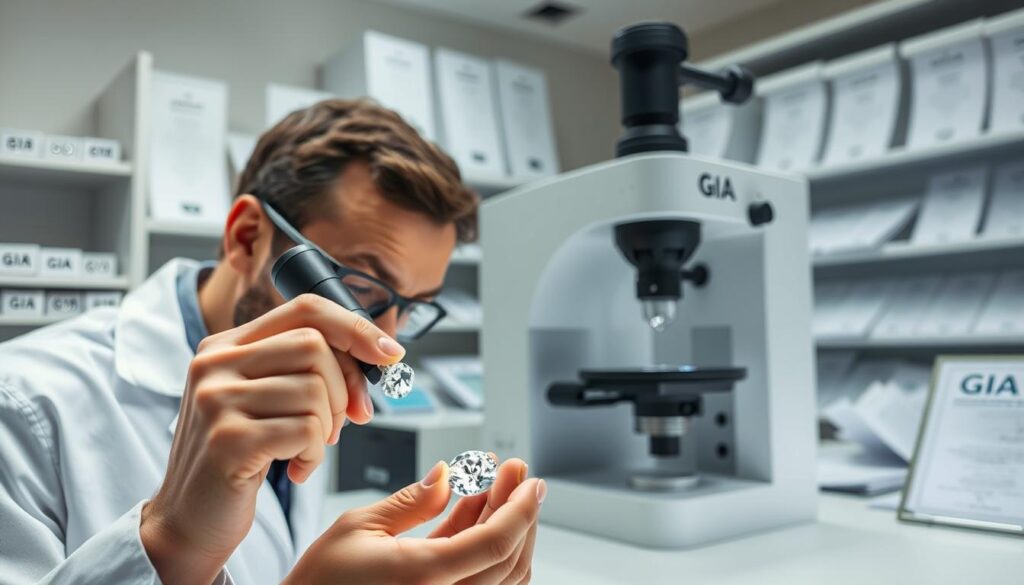
GIA’s New Grading System for Lab Grown Diamonds
In a significant shift, the GIA has overhauled its grading approach for lab-grown diamonds to better reflect their unique characteristics. This change is a response to the rapid advancements in diamond-growing technology, which have led to a “dramatic compression” in the quality range of lab-grown diamonds.
From Traditional Grading to Premium/Standard Categories
The GIA’s new grading system categorizes lab-grown diamonds into Premium and Standard categories, diverging from the traditional grading scale. According to GIA’s data, since 2022, a significant majority (95%) of lab-grown diamonds submitted for grading were colorless, falling within the D-E-F range on the traditional color scale. Moreover, 98% achieved clarity grades of VS1 or higher, indicating a high level of quality.
“This revision will help consumers understand the important differences in the two products’ origin, ensuring their confidence and enabling them to make informed and educated purchase decisions.” – GIA
Why GIA Changed Their Grading Approach
GIA’s decision to change its grading approach stems primarily from the observed “dramatic compression” in the quality range of lab-grown diamonds. With most lab-grown diamonds now falling within the highest color and clarity categories, the traditional grading system became less meaningful. The new system aims to provide a more relevant and practical way for consumers to understand the differences between natural and lab-grown diamonds.
By implementing this new system, GIA aims to maintain its role as a trusted authority while adapting to the unique characteristics and quality patterns of lab-grown diamonds. This change reflects GIA’s commitment to providing relevant information that enables consumers to make informed purchasing decisions in an evolving market.
Pricing of GIA Lab Grown Diamonds
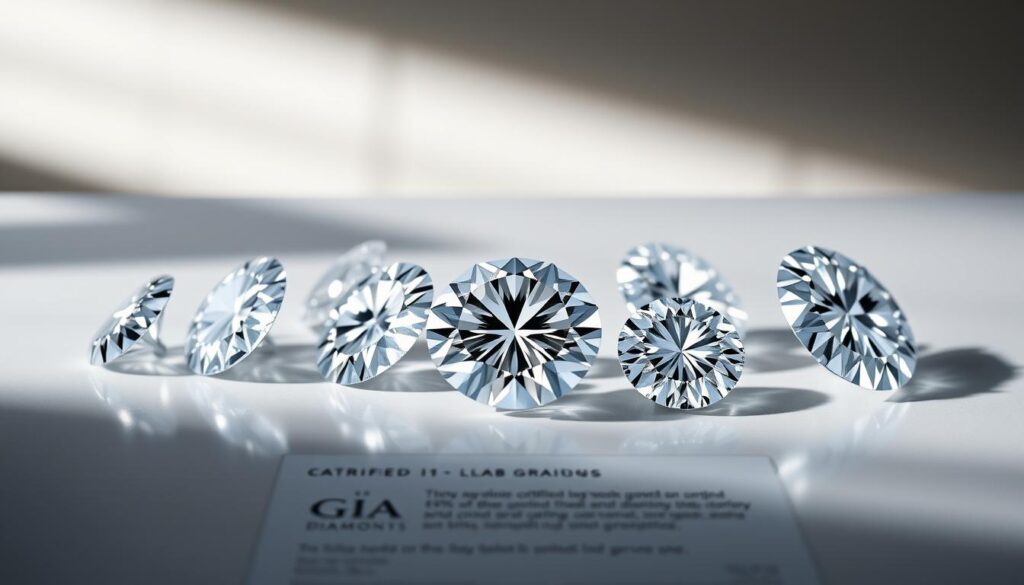
Understanding the pricing of GIA Lab Grown Diamonds is crucial for making informed purchasing decisions. Lab grown diamonds are typically more affordable than natural diamonds, often costing 30-40% less than natural diamonds of comparable quality.
Cost Factors for Lab Grown Diamonds
The cost of lab grown diamonds is influenced by several factors, including carat weight, cut quality, color, and clarity. As the demand for lab grown diamonds continues to grow, production efficiency improvements have led to decreased prices over time. The market trend indicates that lab grown diamond prices will continue to be competitive, making them an attractive option for budget-conscious consumers.
Key cost factors include the diamond’s size, with larger diamonds commanding higher prices due to the increased complexity of production. Additionally, the quality characteristics such as cut, color, and clarity grades play a significant role in determining the final cost.
Price Comparison: Lab Grown vs. Natural Diamonds
When comparing lab grown diamonds to natural diamonds, the price difference is significant. Lab grown diamonds typically cost 30-50% less than natural diamonds of comparable size and quality. This price gap widens as carat weight increases, making lab grown diamonds particularly advantageous for those seeking larger stones.
For equivalent quality characteristics, consumers can purchase a lab grown diamond that is 30-40% larger than a natural diamond at the same price point. The pricing advantage of lab grown diamonds allows consumers to prioritize quality factors that most impact a diamond’s appearance, such as cut quality.
Quality Assessment of GIA Lab Grown Diamonds
Evaluating the quality of GIA Lab Grown Diamonds requires a close look at several key factors. The Gemological Institute of America (GIA) provides a comprehensive assessment that includes the traditional 4Cs and additional features specific to lab grown diamonds.
The 4Cs in Lab Grown Diamond Evaluation
The 4Cs – Carat, Color, Clarity, and Cut – are fundamental in evaluating the quality of lab grown diamonds. GIA’s grading report meticulously documents these characteristics, ensuring that consumers have a clear understanding of their diamond’s quality. The 4Cs provide a universal language for describing diamond quality, making it easier for buyers to compare different stones.
- Carat weight is measured precisely, affecting the diamond’s overall value.
- Color grading ranges from D (colorless) to Z (light yellow or brown), with lab grown diamonds often exhibiting exceptional color quality.
- Clarity refers to the presence or absence of inclusions and blemishes, with clearer diamonds being more valuable.
- Cut quality affects the diamond’s brilliance and fire, with well-cut diamonds refracting light beautifully.
Laser Inscription and Growth Method Identification
GIA lab grown diamonds are laser-inscribed with “Lab Grown” on the girdle, ensuring transparency and preventing misrepresentation. The GIA report also identifies the diamond’s growth method, either High Pressure High Temperature (HPHT) or Chemical Vapor Deposition (CVD), providing insight into the diamond’s origin and process.
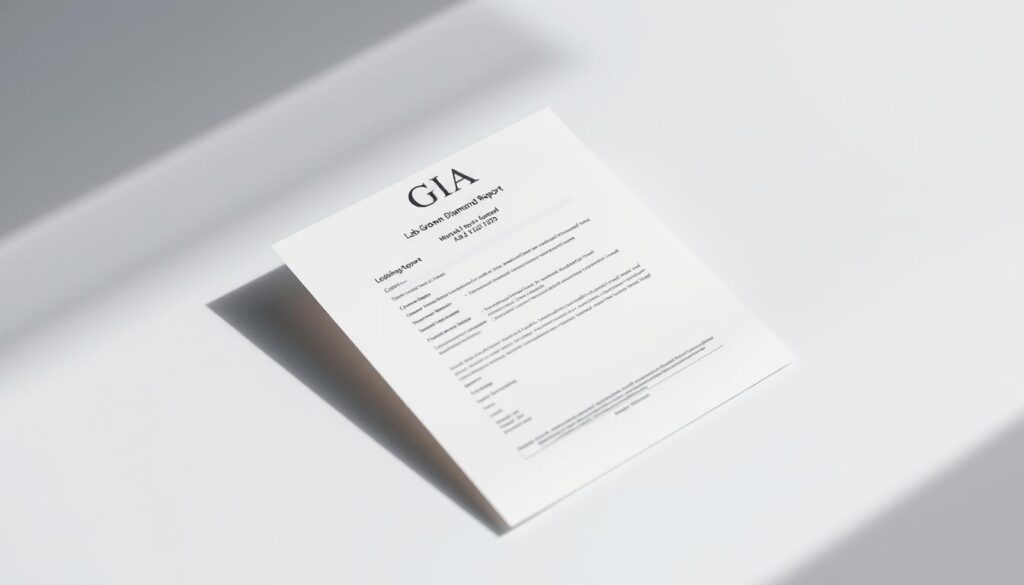
- The laser inscription is a permanent identifier that travels with the stone throughout its lifetime.
- GIA’s assessment includes documenting the specific growth method used, either HPHT or CVD, which can affect the diamond’s characteristics.
- Understanding the growth method can help explain certain optical or physical properties of the stone.
Benefits of Choosing GIA Certified Lab Grown Diamonds
Choosing a GIA certified lab grown diamond offers numerous benefits, including enhanced trust and transparency. When you opt for a GIA certified lab grown diamond, you’re ensuring that your diamond is held to the highest standards of quality and authenticity.
Trust and Transparency in Quality
GIA certification provides a level of transparency that is crucial in the diamond market. A GIA certified lab grown diamond comes with a detailed report that outlines its characteristics, ensuring that consumers have all the information they need to make an informed purchase. This transparency fosters confidence in the quality of the diamond.
The GIA report includes information about the diamond’s origin, confirming that it is a lab grown diamond rather than a natural diamond or simulant. This clarity is essential for consumers who want to ensure they’re getting a genuine lab grown diamond.
Avoiding Misrepresentation in the Market
The GIA certification process includes a laser inscription on the diamond’s girdle, identifying it as “Lab Grown.” This permanent marker helps prevent misrepresentation in the market, ensuring that the diamond is not confused with natural diamonds or other simulants. The detailed documentation provided by GIA also helps to establish the fair market value of the lab grown diamond, based on its actual qualities.
- GIA certification serves as a safeguard against misrepresentation, protecting consumers from potential fraud.
- The laser inscription creates a permanent identifier that remains with the stone throughout its lifetime.
- GIA’s detailed reports distinguish between lab grown diamonds and diamond simulants, preventing confusion.
GIA Lab Grown Diamonds for Engagement Rings
For couples looking for a beautiful and responsible engagement ring, GIA lab grown diamonds are an excellent choice. These diamonds offer the perfect blend of luxury, sustainability, and affordability, making them increasingly popular for engagement rings.
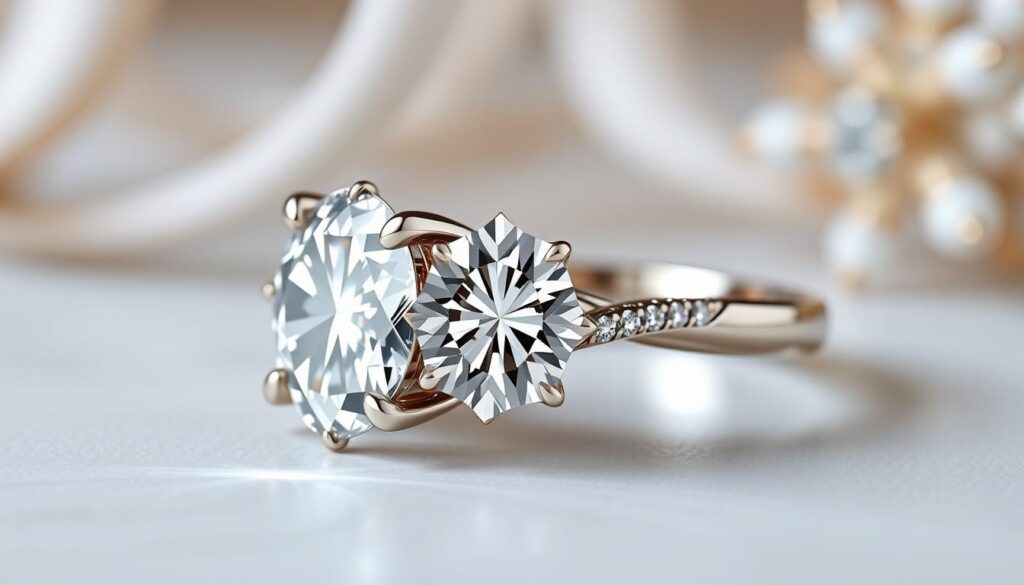
Popular Styles and Settings
GIA lab grown diamonds can be set in a variety of engagement ring styles, from classic solitaire to intricate halo settings. The gia certified diamond ensures that the stone is of the highest quality, regardless of the setting.
The versatility of lab grown diamonds allows couples to choose a diamond engagement ring that suits their personal style, whether traditional or modern.
What to Look for in a GIA Report
When selecting a GIA certified lab grown diamond for an engagement ring, it’s crucial to review the GIA report carefully. The report should include the GIA logo, report number, and date to ensure authenticity.
- Verify that the report clearly identifies the stone as a laboratory-grown diamond and includes information about the growth method used (HPHT or CVD).
- Check that the diamond’s measurements listed on the report match the actual stone you’re considering.
- Pay special attention to the cut assessment, as this factor has the greatest impact on a diamond’s brilliance and overall appearance.
Conclusion: The Future of GIA Lab Grown Diamonds
The future of GIA certified lab grown diamonds is exceptionally bright, driven by technological advancements and increasing consumer demand. As the market continues to mature, GIA’s evolving approach to lab grown diamond certification will play a crucial role in providing consumers with trustworthy and meaningful information.
We can expect continued growth in consumer acceptance of lab grown diamonds, particularly as GIA certification provides the trust and transparency that shoppers demand. The price advantage of lab grown diamonds will likely remain significant, with production efficiencies driving prices lower.
The jewelry industry is adapting to incorporate lab grown diamonds more prominently in their collections, with major brands embracing these stones for their quality and ethical appeal. As sustainability becomes increasingly important, the reduced environmental impact of lab grown diamonds will be a significant factor in their growing popularity.
